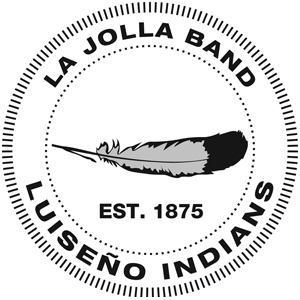La Jolla Band of Luiseño Indians
Background
The La Jolla Reservation spans 8,541 acres along the southern slopes of Mount Palomar and descends in cascading terraces to the cool forests of the upper reaches of the San Luis Rey River. The reservation is located off State Highway 76, 25 miles east of Escondido and 60 miles northeast of San Diego. The La Jolla Reservation was first established by Executive Orders on December 27, 1875, and May 15, 1876. An Executive Order on May 3, 1877, returned some land to the public domain. The present reservation was established on September 13, 1892. A subsequent allotment consisted of 634 acres. The La Jolla Reservation lies within traditional Luiseño territory.
Members of the La Jolla Band belong to the Luiseño Tribe. Tribal members have resided in the region for thousands of years. Luiseño traditional territory originally covered roughly 1,500 miles of southern California to the north of the Kumeyaays’ land, including most of the San Luis Ray and Santa Margarita drainages. The Luiseño language is of the Cupan group of the Takic language, a subfamily of the greater Uto-Aztecan linguistic family. The term Luiseño is derived from the San Luis Rey Mission and has been used in Southern California to refer to those Takic-speaking people associated with the mission.
The reservation is a PL-638 tribe governed by general council composed of all tribal members age 21 and older. The five-member elected tribal council includes a chairperson, a vice-chairperson, and a secretary-treasurer. The tribal council meets monthly and serves two-year terms. The tribe is organized under a non-IRA Articles of Association that was approved in 1962. The La Jolla Tribal Government developed one of the first tribal employment rights offices in California. Government departments include education and culture. The tribe does not maintain its own law enforcement department. However, it is in the process of developing a program through contracts with the BIA and the county sheriff’s office currently provides services.
Tribal Government
| Name | Phone | Fax | Location |
|---|---|---|---|
| Tribal Office | (760) 742-3771 | (760) 742-1704 | 22000 Highway 76 Pauma Valley, CA 92061 |
Community Resources
| Name | Phone | Fax | Location |
|---|---|---|---|
Culture
| Name | Phone | Fax | Location |
|---|---|---|---|
| Culture | (760) 742-3771 |
Education
| Name | Phone | Fax | Location |
|---|---|---|---|
| Valley Center & Pauma Unified School District | (760) 749-0464 | ||
| Fallbrook Union High School District | (760) 723-6332 | (760) 723-1795 | |
| Bonsall Union School District | (760) 631-5200 | (760) 758-3193 |
Citation
Much of the information about the member tribes is taken partly or in some cases entirely from the landmark guide compiled by Dr. Veronica E. Velarde Tiller, Jicarilla Apache and historian: Tiller, Veronica. Tiller's Guide to Indian Country: Economic Profiles of American Indian Reservations. Bowarrow Publishing Company, 1996. ISBN 1-885931-01-8

